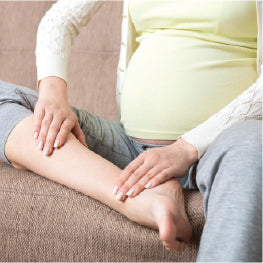What is Hip Bursitis? Injury Overview
Are you worried about hip bursitis?
Read on to find out what causes hip bursitis, how to treat it, and everything else you need to know.

Piriformis Syndrome Injury Overview
Convinced you might be struggling from Piriformis Syndrome? This article offers an extensive overview of this
condition including what it is, symptoms, causes, and more.
Read on to find out what causes hip bursitis, how to treat it, and everything else you need to know.
Piriformis syndrome (Pir-i-form-is) is a condition involving the piriformis muscle, which is located deep in the glutes. It can develop when the muscle spasms or compresses the sciatic nerve, which travels from the lower back down through the leg.
The pain from piriformis syndrome can be tingling and achy and may also radiate down the back of the leg to the calf and foot. Piriformis syndrome can affect participation in certain sports, such as those that involve running.
The piriformis muscle stabilizes the hip joint, which is important for maintaining balance when you are walking. Piriformis syndrome can also make everyday activities, such as sitting, painful. If it is severe enough, the pain can significantly impact the quality of life.
The article below covers what piriformis syndrome is, its causes, symptoms, treatments, and prevention.
What is Piriformis Syndrome?
The piriformis muscle extends from the surface of the pelvis at the base of the spine and runs across the sciatic nerve on top of the femur. Piriformis syndrome can develop when the muscle spasms or becomes inflamed and compresses or puts pressure on the sciatic nerve.
The piriformis plays a role in the stability and movement of the hip joint. When the muscle is injured or weak, it can lead to problems with posture, pain, and instability.
There is no consensus on how common piriformis syndrome is. For example, according to the National Institute of Neurological Disorders and Stroke, it is relatively rare. While some cases may go undiagnosed, estimates are that it might be the cause of 0.3%- 6% of all cases of back pain.
However, other research indicates that the number may be higher. Piriformis syndrome may be responsible for 0.5%-17% of cases of lower back and sciatica pain.
Does it Go Away?
Piriformis syndrome can go away after a few days or weeks. However, a return of symptoms is common when people do not follow their exercise program.
Piriformis Syndrome vs. Sciatica
It is possible to confuse piriformis syndrome with sciatic pain. However, there are differences and similarities between the two.
The sciatic nerve branches out from the lower back and runs through each hip and glute down the thigh and leg.
The sciatic nerve can become irritated, injured, or inflamed. When this occurs, it can cause sharp, burning, or an electrical shock type of pain. Piriformis syndrome can also cause similar symptoms.
Sciatica can develop when the nerve becomes pinched, compressed, or inflamed. This can occur for several reasons, such as:
- Herniated disc
- Bulging disc
- Bone spur
- Injury to the spine
- Infection
Piriformis syndrome may also irritate or compress the nerve, leading to sciatica pain.
The primary difference between piriformis syndrome and sciatica is the cause of the pain. It is the piriformis muscle causing the pain in piriformis syndrome. With sciatica, it could be a number of conditions creating symptoms. The pain may also present differently. With piriformis syndrome, pain is usually in the glute and hip. With sciatica pain, it may travel down the leg.
Piriformis Syndrome Causes and Risk Factors
Various factors may cause or contribute to the development of piriformis syndrome, such as:
- Anatomical variations: Certain anatomical variations of the sciatic nerve can increase the risk of piriformis syndrome. For instance, when the sciatic nerve splits into the tibial and common peroneal nerve, it may increase the risk.
- Tightness: The piriformis muscle can become tight due to poor posture and excessive physical activity.
- Overuse: Overuse of the piriformis muscle, such as repetitive movements from cycling and running, can lead to piriformis syndrome. Prolonged sitting and activities that involve sitting, such as rowing, can also cause inflammation and piriformis syndrome.
- Injury: Trauma to the piriformis muscle may also lead to irritation and inflammation that compresses the sciatic nerve. For example, traumatic injury to the deep posterior thigh or buttocks can affect the piriformis muscle.
Risks
Certain factors may also increase the risk of piriformis syndrome. Risk factors include:
- Female gender: Piriformis syndrome is also much more common in females than males, with a ratio of 6:1. The theory is that more females may develop the condition due to the wider quadriceps femoris muscle in women.
- Age: Although adults of any age can develop piriformis syndrome, it is most commonly diagnosed in middle-aged adults.
- Sedentary lifestyle: A sedentary lifestyle may lead to an overuse injury from sitting too much.
Piriformis Syndrome Symptoms
Symptoms of piriformis syndrome can vary in severity and may include pain in the buttocks and leg that is characterized as aching, shooting, or burning. Additional symptoms include:
- Pain, which may worsen at night
- Numbness and tingling in the buttocks
- Difficulty walking or pain with sitting, standing, or squatting
- Pain, which increases with hip adduction and internal rotation
- Unilateral pain

Symptoms of Piriformis Syndrome From Pregnancy
Piriformis syndrome can develop in pregnancy for a few reasons. For example, during pregnancy, the deep, small muscles of the hip and pelvis are elongated and strained, possibly leading to spasms of the piriformis.
As pregnancy progresses, a change in gait may occur during the later stages, such as excess rotation of the legs outward or a waddling gait.
This can cause overuse of the piriformis muscle and lead to inflammation. Symptoms of piriformis syndrome in pregnancy include:
- Sharp or shooting pain in the glutes
- Tingling or numbness that may radiate to the legs
- Trouble sitting

Piriformis Syndrome From Running
Running involves repetitive motions in the lower body. The piriformis muscle helps stabilize the hip joint and rotate the leg. During running, the piriformis muscle is repeatedly engaged, which can lead to potential strain and overuse. Poor running form, inadequate warmup, and muscle imbalances may increase the risk of piriformis syndrome in runners.

Piriformis Syndrome Diagnosis
It can be challenging to diagnose piriformis syndrome. It is usually a diagnosis of exclusion. Doctors will often make a diagnosis based on a combination of physical exams and possibly imaging tests. The physician may also perform certain stretch tests to determine if the piriformis muscles appear to be irritating the sciatica. Stretch tests may include:
- Beatty: Deep glute pain produced by side lying while the patient is holding a flexed knee several inches off the table
- Freiberg test: Involves forcefully internal rotation of the person's extended thigh
- Pace test: The doctor performs resisted abduction and externally rotates the person's thigh
- FAIR: Involves adduction, flexion, and internal rotation
In some cases, imaging tests are useful to rule out other causes of sciatic pain. For example, magnetic resonance imaging (MRI) may help identify inflammation in the nerves and rule out other causes of nerve entrapment. Doctors may also use other imaging tests, such as X-rays or CT scans.
Piriformis syndrome healing time will vary. Without treatment, if symptoms become severe, piriformis syndrome can become disabling and lead to poor quality of life. With medical management, most people are symptom-free in a few weeks after starting an exercise program. For people who undergo surgery, it may take a few months to return to full activity.
Treatments
The aim of treatment for piriformis syndrome is to decrease compression around the sciatic nerve and to improve the range of motion around the hip. Conservative treatment is the first choice for managing piriformis syndrome.
Depending on the severity of symptoms, home treatment may help. For mild symptoms, treatment may include:
- Rest
- Using heat or ice
- Taking over-the-counter, non-steroidal inflammatory drugs
- Avoid aggravating activities
- Massage the hip and buttock area
When home treatment does not work, additional treatment options include:
- Physical therapy: Physical therapy will include stretching exercises, including external rotation, hip flexion, and adduction movements. Exercises to strengthen the hip extensors, abductors, and external rotators may also be included. Physical therapists may also use ultrasound and soft tissue mobilization.
- Injections: Different types of injections may also help reduce pain and muscle spasms. For instance, Botox injections may relieve spasms leading to pain.
Steroid injections may also be an option for those who do not respond to more conservative treatment. Steroid injections are effective in many cases, although the pain may reoccur. Some studies show about 73.7% of people who received a steroid injection for piriformis syndrome have some reduction in pain.
- Medication: Medication for piriformis syndrome may include non-steroidal anti-inflammatory drugs. Doctors may also recommend neuropathic medications, such as pregabalin and gabapentin, for people who do not respond to non-steroidal medications.
- Surgery: Surgery is often the last resort for piriformis syndrome. It is usually only recommended if symptoms are severe and medical management has not worked. If piriformis syndrome won't go away, surgery may be the best option. The surgical goal is to release the sciatic nerve, which is accomplished by resection of the piriformis muscle.
Prevention Tips
Although it may be difficult to completely prevent piriformis syndrome, there are things someone can do to reduce the risk. Tips to prevent piriformis syndrome include:
- Avoid repetitive activities that aggravate the piriformis muscle
- Always warm up and cool down before engaging in exercise
- Wear proper fitting shoes that provide support
- Maintain correct posture when sitting and standing
- Perform frequent stretching
About the Author

MaryAnn DePietro CRT is a licensed respiratory therapist with over 15 years of clinical experience in critical care, emergency medicine, and pulmonary rehabilitation. She is also an American Council on Exercise certified personal trainer and holds specialty certifications in orthopedics, senior fitness, and weight management. MaryAnn has a degree in Rehabilitation from Penn State University and a degree in respiratory therapy.
In addition to her clinical experience, she has written extensively about all things medical, as well as health, fitness, and aging for various websites, magazines, and newspapers.
About Carex Health Brands
Carex is your one-stop shop for home medical equipment and for products that assist caregivers with providing the best possible support and care for their loved ones. Carex Health Brands has been the branded leader in in-home, self-care medical products for over 35 years. Our goal is to improve the lives of our customers by bring them quality products that bring dignity back to their lives. With our three nationally distributed brands, Carex Health Brands serves national, regional and independent food, drug and mass retailers along with wholesalers, distributors and medical dealers.

